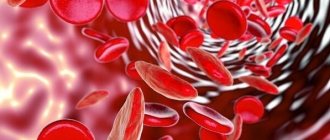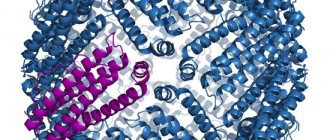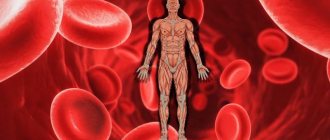Ferritin: what is it?
Ferritin is a complex complex of proteins that plays the role of a battery of iron molecules. From the Latin name of the chemical element iron (ferrum, Fe) comes the name of the iron-containing protein complex - ferritin. It is ferritin that supplies iron to every cell that needs it.
The human body does not synthesize iron itself. This element comes to us with food. The level of iron absorbed directly depends on age. The younger a person is, the higher his ability to isolate this element from food and store it in the form of ferritin. Children in the first year of life can absorb the maximum amount of iron – up to 70% of the amount consumed. By the age of 10 years, the body shaves 7 times less of the incoming volume. Adults receive only 10% of the iron they eat per day.
The chemical processes of a healthy person’s body clearly control the amount of iron in the blood and, if necessary, adjust the distribution of the resulting volume of elements. For example, with a sufficient amount of iron in the body, the absorbed part of it can be set aside as a kind of preparation “for a rainy day” - this is ferritin, which, when the first need arises, will deliver iron in the required volume to the organ in need. And with a reduced concentration of iron in the body, ferritin does not replenish its reserves, since the entire absorbed volume is immediately distributed throughout the tissues.
Ferritin is located in the liver, plasma, bone marrow, placenta and spleen. The level of total ferritin in the body is determined by studying the composition of blood plasma.
Symptoms of iron deficiency
The classic clinical signs of iron deficiency are:
The patient complains of fatigue and fatigue even from the usual load. The main reason is the insufficient supply of oxygen to the cells and tissues of the body. Weakness and lack of endurance are also due to the fact that iron is involved in the production of energy in the form of ATP molecules. In the absence of sufficient oxygen, muscle tissue switches to anaerobic mechanisms for producing ATP, which is less efficient and more taxing on the body. Other common symptoms of anemia include mood swings and irritability . The mechanism of this process is as follows: a lack of iron in the body disrupts the production of the neurotransmitter dopamine and thyroid hormones, which leads to hypothyroidism. Hence the feeling of anxiety, stress, irritability and mood swings.- The next symptom of iron deficiency is decreased concentration . As you know, oxygen is one of the factors that ensures the activity and high performance of the brain. Its deficiency in anemia is the cause of impairment of the subtle cognitive functions of the brain. Many patients with low iron levels in the body experience attacks of dizziness. Frequent dizziness is also the result of a lack of oxygen in red blood cells. The same series of symptoms of anemia include unexplained frequent headaches. Lack of iron leads not only to a decrease in hemoglobin content, but also disrupts the formation of another iron-containing protein - myoglobin. This leads to soreness and tension in the muscles of the face, neck and shoulders, which explains frequent headaches in iron deficiency.
A number of patients with anemia complain of sleep disturbances . Ferritin, the main protein that stores iron, is one of the most important regulators of sleep. Insomnia in iron deficiency occurs when iron reserves are depleted at the earliest stages of the pathological process, since ferritin is the first to disappear.- Visible changes in anemia in men and women occur in the skin and nails : the surface of the lips looks dry and cracked, the nails become brittle and longitudinally striated. Ferritin is an essential component necessary for the normal processes of tissue regeneration and renewal, especially the skin and its appendages (hair, nails). Depletion of ferritin stores leads to deterioration of cellular repair processes in these tissues. The skin and mucous membranes of patients with anemia are usually pale, this is especially noticeable when hemoglobin drops below 90 g/l. First of all, those areas where the blood flow is closest to the surface of the skin or mucous membrane turn pale: lips, conjunctiva, palms, nail beds.
- , restless legs syndrome or Willis-Ekbom disease may occur A deficiency of the element in the body leads to an imbalance between the synthesis of dopamine and the metabolism of thyroid hormones. To make such a diagnosis, the presence of 4 main signs is necessary: the need to move the legs to overcome unpleasant sensations in the limbs;
- unpleasant sensations in the legs arise and intensify at rest;
- unpleasant sensations partially or completely disappear in an active state (running, walking);
- the need to move the legs and discomfort intensify in the evening and often cause insomnia.
Ferritin: normal levels
Various diseases or certain physiological processes can affect ferritin levels. Natural reasons for decreased performance include:
- periodic female bleeding;
- pregnancy;
- dieting.
To monitor health status as a preventive measure, as well as in case of symptoms typical of iron deficiency, a biochemical blood test for ferritin is performed. The collected biomaterial is examined to understand how many micrograms of iron are contained in one liter of plasma.
The norms for each age group are different:
- in newborns from 25 to 600 mcg/l;
- in children older than 28 days, but not yet 9 weeks of age, the norm is 20-600 mcg/l;
- in children from 2 to 5 months it should be from 50 to 200 mcg/l;
- children aged from six months to one year should have from 70 to 140 mcg/l;
- girls and women over 12 years of age should have a normal level of 22 to 180 mcg/l;
- boys and men over 12 years old - from 30 to 310 mcg/l.
Women's blood contains less ferritin because it contains less hemoglobin, red blood cells and iron molecules. In addition, pregnancy makes its own adjustments to ferritin levels:
- in the first trimester of pregnancy, levels can reach 90 mcg/l;
- in the second trimester, blood contains up to 74 mcg/l;
- and the third trimester is famous for its low ferritin level - only 10-15 mcg/l.
Ferritin is a protein in which iron is stored in tissues.
Synonyms Russian
Deposited iron, metalloprotein, indicator of iron reserves.
English synonyms
Ferritin.
Research method
Immunoturbidimetry.
Units
μg/L (micrograms per liter).
What biomaterial can be used for research?
Venous blood.
How to properly prepare for research?
- Do not eat for 8 hours before the test; you can drink clean still water.
- Stop taking medications containing iron 72 hours before the test.
- Avoid physical and emotional stress and do not smoke for 30 minutes before the test.
General information about the study
Ferritin is a protein in the form in which iron is mainly stored in the body.
It is absorbed from food and then transferred by transferrin, a special protein that is formed in the liver. Iron is necessary for the formation of red blood cells and is an essential part of hemoglobin, a protein that fills red blood cells and allows them to carry oxygen from the lungs to organs and tissues. In addition, it is part of the muscle protein myoglobin and some enzymes.
Normally, the body contains 4-5 grams of iron. About 70% of this amount is iron, “built-in” into the hemoglobin of red blood cells. The remainder is mainly stored in tissues as part of protein complexes - ferritin and hemosiderin - which are mainly found in the liver, as well as in the bone marrow, spleen and muscles. Although ferritin is present in small amounts in the blood, its concentration reflects the body's iron stores.
When iron begins to be scarce, for example, in the case of reduced intake of it with food or frequent bleeding, the body begins to use reserves from tissues. The amount of ferritin decreases accordingly. A long-term lack of iron intake can lead to anemia. Ferritin levels can be reduced long before the symptoms of iron deficiency appear and allow anemia to be diagnosed in time.
On the other hand, if too much iron is taken in, it can lead to excessive iron accumulation and, as a result, damage to the liver, heart and pancreas.
It is worth noting that the use of various tests that reflect iron metabolism in the body provides more complete and reliable information about the deficiency or excess of this microelement than just a ferritin test.
What is the research used for?
- To assess iron reserves in the body. This is necessary to identify iron deficiency or excess.
- To determine whether anemia is caused by a lack of iron or other causes, such as a chronic illness or lack of vitamin B12.
When is the study scheduled?
- If abnormalities are detected in tests such as general blood count, hemoglobin, hematocrit, red blood cell count.
- If you suspect a deficiency or excess of iron in the body.
In the early stages, iron deficiency may be asymptomatic. If a person is otherwise healthy, then signs of the disease sometimes appear only when hemoglobin drops below 100 g/l. The development of anemia is indicated by the following complaints: chronic weakness/fatigue, dizziness, headaches.
With severe anemia, the patient may suffer from shortness of breath, chest pain, severe headaches, and weakness in the legs. Children have learning difficulties.
In addition to the main ones, there are several more signs characteristic of iron deficiency: the desire to eat unusual foods (chalk, clay), burning of the tip of the tongue, jams - cracks in the corners of the mouth.
- If you suspect iron overload (hemochromatosis). This condition can manifest itself in different ways, for example, pain in the joints, abdominal pain, weakness, fatigue, decreased sexual desire, and irregular heart rhythm.
- When monitoring the effectiveness of treatment of anemia and conditions accompanied by iron overload.
What do the results mean?
Reference values
| Age | Reference values |
| 1-2 months | 200 - 600 µg/l |
| 2-5 months | 50 - 200 µg/l |
| 5 months – 15 years | 7 - 140 µg/l |
| Men over 15 years old | 20 - 250 µg/l |
| Women over 15 years old | 10 - 120 µg/l |
Reasons for low ferritin levels
- Iron deficiency, including hidden. A decrease in ferritin below 10 ng/ml usually indicates iron deficiency anemia.
- Third trimester of pregnancy. A decrease in the amount of iron in this case is normal.
Causes of increased ferritin levels
- Hereditary hemochromatosis. In this disease, too much iron is absorbed from food and deposited in various organs, causing them to become damaged.
- Multiple blood transfusions, intramuscular iron administration, administration of iron tablets.
- Inflammations, such as upper respiratory tract infections, urinary tract infections, autoimmune diseases. Moreover, an increase in ferritin in the acute phase of inflammation can mask the existing iron deficiency.
- Acute or chronic liver diseases.
- Alcoholism.
- Hemolytic anemia: associated with the destruction of red blood cells, B12 deficiency anemia, thalassemia.
- Hyperthyroidism – increased function of the thyroid gland.
- Oncological diseases of the bone marrow, breast cancer, Hodgkin's disease - a malignant neoplasm of lymphoid tissue. Ferritin levels will increase significantly.
What can influence the result?
- Falsely increased results can be caused by: fasting,
- alcohol, estrogens, oral contraceptives, iron supplements.
Why is low ferritin dangerous?
A decrease in ferritin levels is primarily an indication for analysis of the nutritional system. Most often, insufficient iron levels in the blood are caused by improper diets or fasting. The second most popular cause is bleeding and diseases of the digestive system. With blood loss, large volumes of iron leave the body, and due to impaired absorption function, the deficiency cannot be replenished.
With a lack of ferritin, the following symptoms appear:
- brittle nails;
- hair loss;
- decreased libido;
- mood swings;
- increased heart rate;
- dizziness;
- memory impairment.
Low ferritin, if not detected in time, and nutrition adjustments and the necessary treatment are not started, can become an impetus for the development of iron deficiency anemia.
High ferritin levels
High ferritin, close to the normal limit, indicates that tissues and organs receive a sufficient amount of iron every day from the diet, thanks to which the body is able to store reserves of an important element. If the values obtained as a result of laboratory tests gave inflated indicators, significantly beyond the acceptable limits, this is a reason to examine to identify:
- oncology;
- infection with the immunodeficiency virus;
- problems in the functioning of the endocrine system.
Separately, you need to analyze your diet. Perhaps excess iron can easily be explained by a diet rich in this element.







